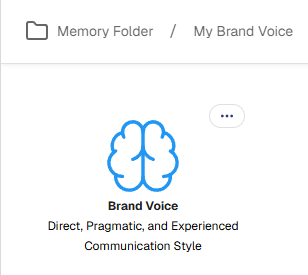Marketr AI's Memory is a powerful feature designed to ensure consistency, efficiency, and accuracy in your content generation by allowing you to store and recall specific information, styles, and brand guidelines across different projects and conversations. It's distinct from the temporary chat history of a single session.

Marketr's Memory is a persistent storage mechanism where you can intentionally save predefined sets of data, such as:
- Brand Voice & Tone: Specific linguistic patterns, vocabulary, and overall stylistic preferences unique to your brand.
- Key Information: Factual details, product specifications, company history, or any critical data you want the AI to consistently reference.
- Persona Guidelines: Instructions for the AI to adopt a specific persona when generating content.
- Content Structures: Preferred formats, outlines, or frameworks for different types of marketing assets.
Unlike a typical chat log, which is a chronological record of your conversation, the Memory is a curated library of assets that you actively manage and deploy.
Marketr's Memory is a persistent storage mechanism where you can intentionally save predefined sets of data, such as:
- Brand Voice & Tone: Specific linguistic patterns, vocabulary, and overall stylistic preferences unique to your brand.
- Key Information: Factual details, product specifications, company history, or any critical data you want the AI to consistently reference.
- Persona Guidelines: Instructions for the AI to adopt a specific persona when generating content.
- Content Structures: Preferred formats, outlines, or frameworks for different types of marketing assets.
Unlike a typical chat log, which is a chronological record of your conversation, the Memory is a curated library of assets that you actively manage and deploy.
How It Works:
- Creation and Curation: You proactively create and curate "memory types" or "memory files" within Marketr. This often involves feeding the AI examples of your desired output (e.g., existing brand copy, style guides, or even personal writings) and defining specific parameters.
- Analysis and Definition: Marketr analyzes the provided input to understand the underlying patterns, vocabulary, and stylistic nuances. For instance, when creating a brand voice memory, it learns your unique way of communicating.
- Manual Loading: Crucially, Marketr's Memory is not automatically active in every new chat. To apply a saved memory, you must manually load it into your current conversation or project. This gives you precise control over when and where specific contexts or styles are applied.
- Persistent Context: Once loaded, the memory provides a persistent context for the AI, guiding its responses and generations according to the saved parameters. This means Marketr won't "forget" your brand voice or key facts from one session to the next, even if you start a completely new chat.
- Efficiency and Token Savings: By loading a pre-defined memory, you eliminate the need to repeatedly re-prompt the AI with the same instructions or context. This saves time, reduces repetitive effort, and can lead to more efficient "token" usage, as the AI doesn't have to re-process extensive chat histories to recall your preferences.
- Refinement and Iteration: You can continuously refine your saved memories. For example, if you notice Marketr is still using a generic phrase despite your brand voice memory, you can edit the memory's description or add negative prompts to improve its adherence to your guidelines.
In essence: Marketr's Memory acts as your personalized style guide and knowledge base for the AI, ensuring that every piece of content it generates aligns perfectly with your brand and objectives, without requiring constant reiteration.
Understanding and Utilizing Marketr's Memory
- Memory vs. Chat History: It's vital to understand that Marketr's "memory" is not the same as your chat history. Memory refers to specific data points, styles, or information you manually save and load into new conversations. This allows for persistent context without burdening each new chat with previous interactions.

- Purpose of Access Memory: Use the "access memory" feature to capture and transfer specific language styles, tone, or factual information (referred to as "memory types") between different chat threads. This process significantly reduces the "token" cost and time required for the AI to analyze and adapt to your desired context in new projects.

- Manual Loading for New Chats: For new projects or conversations, remember to manually load the relevant "memory" files. This ensures Marketr starts with the correct foundational knowledge and stylistic guidelines, saving you from re-prompting these details every time.
- Utilize Access Memory for Efficiency: Leverage the "access memory" feature to save and transfer specific language patterns and memory types between different chats. This saves time and "tokens" by preventing the AI from having to re-analyze long or older conversations to understand your desired style.
Create Memory (e.g. your Brand Voice)
To create a memory, click Access memory in the left navigation panel, then select Create memory.

Then upload a file that is showing your "Brand Voice".
- Define Your Brand Voice Early: Marketr also can help you define and embed your brand voice.

- Refine Your Brand Voice Negatively: You can instruct Marketr's brand voice to avoid certain generic AI phrases or clichés (e.g., "whisper," "quiet as an adjective," "everything shifts"). This helps ensure your content sounds unique and authentic to your brand.

- Edit Access Memory Descriptions: After Marketr analyzes your brand voice or other input, you can edit the text description within the specific access memory folder. This allows for precise refinement of the AI's understanding and output.


- Source Material for Brand Voice Analysis: To effectively establish your brand voice, provide Marketr with existing written content such as social media posts, media articles, or even personal journaling. This gives the AI rich data to analyze and replicate your unique style. Save your brand voice and enjoy it!

Was this article helpful?
That’s Great!
Thank you for your feedback
Sorry! We couldn't be helpful
Thank you for your feedback
Feedback sent
We appreciate your effort and will try to fix the article